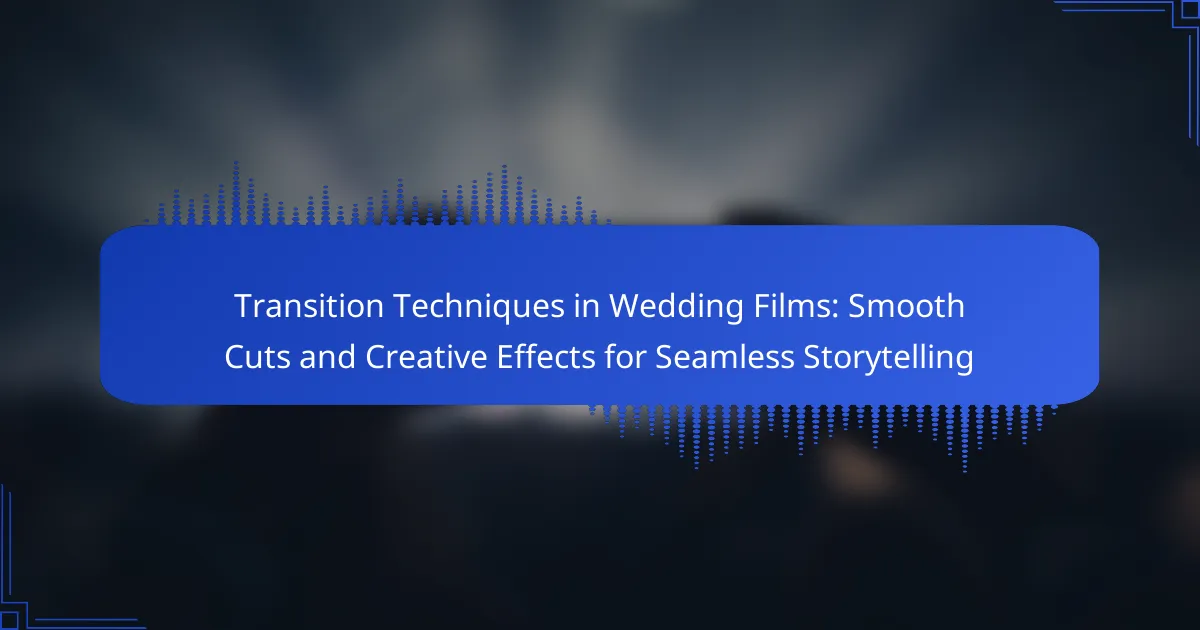Transition techniques in wedding films are essential methods for moving seamlessly between scenes, enhancing the overall storytelling experience. This article covers various transition techniques, including cuts, fades, and wipes, highlighting their specific purposes in conveying emotions and indicating the passage of time. For instance, fades to black often signify the conclusion of significant moments, while smooth cuts help maintain pacing. Additionally, creative effects such as match cuts and cross dissolves are discussed for their role in adding visual interest. Understanding these techniques is crucial for achieving a cohesive narrative in wedding films.

What are Transition Techniques in Wedding Films?
Transition techniques in wedding films are methods used to move smoothly from one scene to another. These techniques enhance storytelling by maintaining viewer engagement. Common transition techniques include cuts, fades, and wipes. Each technique serves a specific purpose in conveying emotion or time passage. For example, a fade to black can signify the end of a significant moment. Smooth cuts help maintain the film’s pacing. Creative effects, like match cuts or cross dissolves, add visual interest. These techniques are essential for creating a cohesive narrative in wedding films.
How do transition techniques enhance storytelling in wedding films?
Transition techniques enhance storytelling in wedding films by creating smooth visual connections between scenes. These techniques maintain narrative flow and engage viewers. For example, a fade transition can evoke emotions, signaling a change in mood or time. Cuts can highlight key moments, ensuring the story remains dynamic and captivating. Creative effects, such as cross-dissolves, blend moments seamlessly, enriching the overall experience. By using these techniques, filmmakers can emphasize important details, guiding the audience through the emotional journey of the day. This approach results in a cohesive narrative that resonates with viewers long after the film ends.
What are the most common types of transition techniques used?
The most common types of transition techniques used in wedding films include cuts, fades, and dissolves. Cuts are direct transitions between scenes, providing a seamless flow. Fades involve gradually transitioning from a scene to black or white, creating a softer change. Dissolves blend one scene into another, allowing for a smooth visual transition. These techniques enhance storytelling by maintaining the audience’s engagement. Research indicates that effective transitions can significantly impact viewer perception and emotional response, making them essential in wedding filmmaking.
How do different transitions affect the emotional tone of a wedding film?
Different transitions can significantly affect the emotional tone of a wedding film. For instance, smooth cuts often create a sense of continuity and flow, enhancing feelings of joy and celebration. In contrast, abrupt transitions can evoke surprise or tension, altering the viewer’s emotional response. Fade-ins and fade-outs typically introduce a reflective or sentimental mood, making moments feel more poignant. Cross-dissolves blend scenes gently, which can evoke nostalgia or warmth. The choice of transition directly influences how viewers perceive the narrative and emotional depth of the film. Studies in film theory indicate that transitions shape audience engagement and emotional resonance with the storyline.
Why are smooth cuts important in wedding filmmaking?
Smooth cuts are important in wedding filmmaking because they enhance the flow of the narrative. They create a seamless transition between scenes, maintaining viewer engagement. Smooth cuts help to preserve the emotional tone of the event. They allow for a natural progression in storytelling, making the film feel cohesive. Additionally, they minimize distractions that can detract from the overall experience. Research shows that effective transitions improve audience retention of visual content. This technique is essential for creating a polished and professional final product.
What are the characteristics of a smooth cut?
A smooth cut is characterized by a seamless transition between two shots. This technique maintains continuity in action or dialogue. It ensures that the viewer’s attention is not disrupted. A smooth cut often matches the pacing of the scene. It can utilize similar framing or composition between shots. This technique enhances storytelling by providing a fluid viewing experience. Additionally, sound continuity is crucial for a smooth cut. The audio should blend naturally from one shot to the next.
How can smooth cuts improve the viewer’s experience?
Smooth cuts enhance the viewer’s experience by creating a seamless flow between scenes. This technique maintains narrative continuity and keeps the audience engaged. When transitions are smooth, viewers can focus on the story without distraction. Research shows that effective transitions can increase viewer retention and emotional connection. A study by the University of Southern California found that smooth edits lead to higher viewer satisfaction. This satisfaction arises from reduced cognitive load, allowing for a more immersive experience. Overall, smooth cuts are essential for effective storytelling in wedding films.
What creative effects can be used alongside transitions?
Creative effects that can be used alongside transitions include fades, wipes, and dissolves. Fades gradually transition from one scene to another, often creating a soft effect. Wipes replace one shot with another through a defined motion, adding energy to the transition. Dissolves blend two shots together, allowing for a smooth visual flow. These effects enhance storytelling by emphasizing emotional moments. They can also guide the viewer’s attention between scenes. Using these effects strategically can elevate the overall production quality of wedding films.
How do creative effects complement smooth cuts in storytelling?
Creative effects enhance smooth cuts in storytelling by adding visual interest and emotional depth. They can transform a simple transition into a more engaging experience. For instance, a fade or dissolve can signify a passage of time or shift in mood. This allows the audience to connect with the narrative on a deeper level. Research shows that effective transitions can improve viewer retention and emotional engagement. According to a study published in the Journal of Visual Communication, creative effects can lead to a 30% increase in audience immersion. Thus, combining smooth cuts with creative effects creates a more cohesive and impactful storytelling experience.
What are some examples of popular creative effects in wedding films?
Popular creative effects in wedding films include slow motion, time-lapse, and aerial shots. Slow motion captures emotional moments, allowing viewers to savor key scenes. Time-lapse showcases the progression of events, such as the setup of the venue. Aerial shots provide stunning views of the venue and guests, enhancing the film’s visual appeal. Other effects include color grading for mood enhancement and transitions like match cuts for seamless storytelling. Each effect contributes to the overall narrative and emotional impact of the wedding film.
How do transitions impact the pacing of a wedding film?
Transitions significantly influence the pacing of a wedding film. They serve as bridges between scenes, affecting the flow of the narrative. Smooth transitions create a seamless experience, enhancing viewer engagement. Conversely, abrupt transitions can disrupt the story’s rhythm. The choice of transition type can evoke specific emotions. For instance, slow fades may suggest nostalgia, while quick cuts can convey excitement. Properly timed transitions align with the film’s overall tempo. This alignment helps maintain audience interest throughout the film.
What are the best practices for using transitions in wedding films?
Best practices for using transitions in wedding films include maintaining a consistent style and ensuring they serve the narrative. Transitions should enhance storytelling without overwhelming the viewer. Simple cuts and fades are often most effective for emotional moments. Creative transitions can be used sparingly to highlight significant changes or themes. Match the transition type to the mood of the scene for better impact. Avoid excessive use of flashy effects, as they can distract from the main content. Consider the pacing of the film; transitions should flow naturally with the rhythm of the music. Lastly, test transitions during editing to ensure they resonate well with the overall film.
How can filmmakers choose the right transition for each scene?
Filmmakers can choose the right transition for each scene by considering the emotional tone and narrative flow. Each transition should enhance the storytelling, not distract from it. For instance, a fade may signify the passage of time, while a cut can create urgency. Filmmakers should analyze the pacing of the scene. A fast-paced scene may benefit from quick cuts, while a slower scene might use dissolves. Additionally, the context of the scenes is crucial. Transitions should reflect the relationship between the two scenes. For example, a match cut can link similar actions or themes. Understanding the audience’s emotional response is also important. The chosen transition should evoke the intended feelings. Ultimately, the right transition complements the visual and auditory elements of the film.
What common mistakes should be avoided when applying transitions?
Common mistakes to avoid when applying transitions include overusing them, which can distract from the story. Transitions should enhance the narrative, not overwhelm it. Another mistake is mismatching transitions with the tone of the footage. For instance, a fast-paced transition may not suit a slow, emotional scene. Additionally, failing to maintain continuity can confuse viewers. Each transition should logically connect scenes. Not considering the audience’s perspective is also a mistake. Transitions should resonate with viewers and support their understanding of the story. Finally, neglecting to practice transitions can lead to awkward cuts. Practicing ensures smooth execution during editing.
What tips can help filmmakers master transition techniques?
Filmmakers can master transition techniques by practicing various methods. First, they should understand the different types of transitions, such as cuts, fades, and wipes. Each transition serves a unique purpose in storytelling. Next, filmmakers should consider the pacing of their edits. Smooth transitions often align with the rhythm of the soundtrack. Additionally, filmmakers can use visual motifs to create seamless transitions. This technique maintains thematic consistency throughout the film. Practicing with software tools can enhance their editing skills. Familiarity with editing programs allows for more creative freedom. Lastly, analyzing films known for their transition techniques provides valuable insights. Studying successful examples can inspire filmmakers to innovate in their own work.
Transition techniques in wedding films are essential methods for achieving smooth scene transitions that enhance storytelling and viewer engagement. This article explores various transition techniques, including cuts, fades, and creative effects, and how they impact the emotional tone and pacing of wedding films. Key practices for selecting and applying transitions effectively are discussed, along with common mistakes to avoid. Additionally, tips for mastering these techniques are provided, underscoring their importance in creating a cohesive narrative that resonates with audiences.



